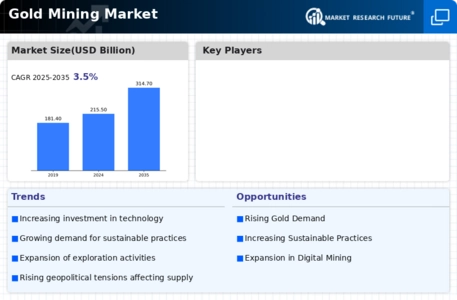Gold Mining Size
Gold Mining Market Growth Projections and Opportunities
Gold Mining Market Size was valued at USD 201.2 Billion in 2022. The Gold Mining industry is projected to grow from USD 208.2 Billion in 2023 to USD 274.2 Billion by 2032, exhibiting a compound annual growth rate (CAGR) of 3.50%
The gold mining market is intricately influenced by a multitude of factors that collectively shape its growth and dynamics within the global economy. Economic conditions, geopolitical factors, technological advancements, and societal trends all play pivotal roles in determining the trajectory of the gold mining industry. Economic stability is a fundamental driver for the gold mining market. Traditionally viewed as a safe-haven asset, gold demand tends to rise during periods of economic uncertainty or financial market volatility. Investors often turn to gold as a store of value and a hedge against inflation, impacting the demand and pricing of the precious metal.
Geopolitical factors exert a significant influence on the gold mining market, given the global distribution of gold deposits. Political stability, trade relations, and international tensions can impact gold supply chains, trade dynamics, and pricing. Geopolitical events, such as geopolitical tensions, trade disputes, or geopolitical crises, may lead to increased demand for gold as a perceived safe asset, affecting its market value. Gold mining companies must navigate geopolitical uncertainties to ensure secure access to resources and stability in market conditions.
Technological advancements in mining techniques and extraction processes contribute to the efficiency and sustainability of gold mining operations. Innovations in exploration technologies, ore processing methods, and environmental management practices enhance the industry's ability to extract gold economically and responsibly. Advanced equipment, including autonomous vehicles and advanced sensor technologies, improves safety and operational efficiency in gold mines. Moreover, advancements in gold refining technologies contribute to the production of high-purity gold, meeting the stringent requirements of various industries.
Environmental considerations are increasingly influencing the gold mining market. Responsible mining practices, environmental impact assessments, and adherence to sustainability standards are becoming integral aspects of the industry. Gold mining companies are adopting eco-friendly technologies, reclamation practices, and waste management strategies to minimize their environmental footprint. Compliance with stringent environmental regulations and engagement with local communities are essential for maintaining a positive reputation and social responsibility in the industry.
Market demand for gold is significantly influenced by various sectors, including jewelry, investment, and central bank reserves. Jewelry represents a substantial portion of gold demand, particularly in regions with strong cultural and historical ties to gold adornment. Investment demand for gold is driven by factors such as economic uncertainties, currency fluctuations, and inflation fears. Central banks play a critical role in gold demand by accumulating gold reserves as a form of monetary security. Trends in these sectors, along with shifts in consumer preferences and investment strategies, impact the overall demand for gold in the market.
Market competition in the gold mining industry is shaped by factors such as production costs, exploration success, and operational efficiency. Gold mining companies compete based on their ability to discover economically viable deposits, extract gold cost-effectively, and manage their operational risks. Efficient mining practices, technological innovation, and strategic exploration play crucial roles in maintaining competitiveness. Companies that can balance cost-effective production with responsible environmental and social practices are better positioned to thrive in the competitive gold mining market.



 Source: Secondary Research, Primary Research, Market Research Future Database and Analyst Review
Source: Secondary Research, Primary Research, Market Research Future Database and Analyst Review
Leave a Comment